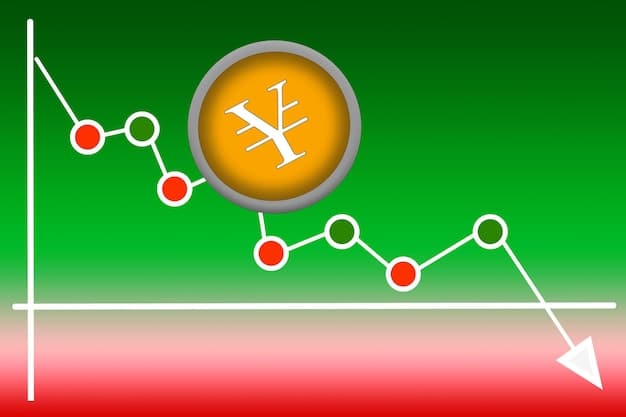Dollar-Cost Averaging: Reduce Investment Risk in 2025

Dollar-cost averaging (DCA) is an investment strategy that involves dividing the total amount to be invested across periodic purchases of a target asset, aiming to reduce the impact of volatility on the overall purchase price and mitigate potential investment risk in 2025.
Investing can feel like navigating a storm, especially with unpredictable market fluctuations. What is Dollar-Cost Averaging and How Can It Reduce Your Investment Risk in 2025? This strategy offers a methodical approach to investing, smoothing out the impact of market volatility and potentially enhancing your long-term returns.
Understanding Dollar-Cost Averaging
Dollar-cost averaging (DCA) is a simple yet powerful strategy where you invest a fixed amount of money at regular intervals, regardless of the asset’s price. This approach contrasts with lump-sum investing, where you invest the entire sum at once.
The core idea behind DCA is to buy more shares when prices are low and fewer shares when prices are high. Over time, this can lead to a lower average cost per share compared to buying all shares at a single, potentially high, price.

How Dollar-Cost Averaging Works
Let’s illustrate how DCA works with a real-world example. Imagine you have $12,000 to invest in a stock. Instead of investing the entire $12,000 at once, you decide to invest $1,000 each month for 12 months.
- Consistent Investment: You invest $1,000 every month, rain or shine.
- Varying Share Prices: Some months, the stock price might be high, so you buy fewer shares. Other months, the price might be low, and you buy more shares.
- Averaging Out: Over the 12-month period, you accumulate shares at different prices, effectively averaging out your cost per share.
This approach helps mitigate the risk of investing a large sum right before a market downturn, potentially leading to a more favorable average purchase price over time.
Dollar-cost averaging offers a strategic way to enter the market, reducing the emotional pressure of timing your investments perfectly. By consistently investing a fixed amount, you can potentially benefit from market volatility and achieve better long-term returns.
The Benefits of Dollar-Cost Averaging in 2025
Dollar-cost averaging offers numerous advantages, particularly in volatile markets. These benefits can be especially relevant for investors in 2025, given the ever-changing economic landscape.
One of the primary benefits is reduced risk. By spreading out your investments over time, you lessen the impact of short-term market fluctuations, protecting your portfolio from significant losses due to poor timing.
Mitigating Market Volatility
Volatility can be a daunting aspect of investing. DCA helps smooth out the highs and lows, providing a more predictable investment journey. This is particularly useful when the market is experiencing significant swings, as it prevents you from making emotionally driven decisions.
Emotional Discipline
Investing can be emotional, with fear and greed often dictating decisions. DCA removes much of this emotion by automating the investment process. You invest regularly, regardless of market conditions, promoting disciplined investing habits.

Potential for Long-Term Growth
While DCA isn’t a get-rich-quick scheme, it sets the stage for long-term growth. By consistently investing over time, you take advantage of compounding returns, which can significantly boost your portfolio’s value over the years.
- Reduces Stress: DCA can make investing less stressful by removing the pressure to time the market.
- Promotes Consistency: Encourages regular investing habits, which are crucial for long-term financial success.
- Averages Purchase Price: Lowers the average cost per share, potentially leading to higher returns over time.
Dollar-cost averaging helps investors navigate market uncertainties with confidence, fostering disciplined investing habits and unlocking potential long-term growth opportunities.
Dollar-Cost Averaging vs. Lump-Sum Investing
Deciding between dollar-cost averaging and lump-sum investing depends on your financial goals, risk tolerance, and market outlook. Each strategy has its own set of pros and cons.
Lump-sum investing involves investing the entire sum of money at once. Historically, it has often outperformed DCA, particularly in consistently rising markets. However, it also carries a higher risk of investing right before a market downturn.
When to Choose Lump-Sum Investing
Lump-sum investing might be the preferred choice if you have a strong belief in the long-term growth potential of your chosen asset and are comfortable with short-term volatility. It can also be beneficial if you anticipate a significant market upswing.
However, do not choose Lump-sum investing if:
- Market is Volatile: You are worried about buying at the peak and seeing immediate losses.
- Emotional Investing: You tend to make impulsive decisions based on market fluctuations.
- Uncertainty: You lack confidence in the long-term performance of your chosen asset.
When to Choose Dollar-Cost Averaging
Dollar-cost averaging is a more conservative approach, suitable for those who are risk-averse or uncertain about the market’s direction. It reduces the risk of buying at the high and provides a smoother investment experience.
Dollar-cost averaging can often be a great starting point for:
- Reducing Risk: You want to minimize the potential impact of market volatility.
- Promoting Discipline: You need a structured approach to ensure consistent investing.
- Easing In: You are new to investing and want to gradually build your portfolio.
The choice between DCA and lump-sum investing depends on your circumstances and investment philosophy. Both strategies have their place in a well-rounded investment plan, but DCA often provides a gentler introduction to the world of investing, particularly in uncertain times.
Implementing Dollar-Cost Averaging in Your Portfolio
Implementing dollar-cost averaging is straightforward. It involves setting up a regular investment schedule and sticking to it, regardless of market fluctuations.
Begin by determining the total amount you want to invest and the time frame over which you plan to invest it. Divide the total amount by the number of investment periods to determine the amount you’ll invest each time.
Setting Up Your Investment Schedule
Consistency is key to the success of DCA. Choose a schedule that works for you, whether it’s weekly, bi-weekly, or monthly, and adhere to it diligently. Consistency helps you take advantage of market fluctuations and potentially lower your average cost per share.
Choosing the Right Assets
DCA can be applied to a variety of assets, including stocks, bonds, mutual funds, and exchange-traded funds (ETFs). Select assets that align with your investment goals and risk tolerance. Diversifying your portfolio can further reduce risk and enhance long-term returns.
Assets that might be considered as Dollar-cost averaging:
- Stocks: Individual stocks or stock mutual funds
- Bonds: Government or corporate bonds
- ETFs: Broad market or sector-specific ETFs
Reinvesting Dividends
Consider reinvesting dividends to further enhance your returns. Reinvesting dividends allows you to purchase additional shares, compounding your gains over time. This can be a powerful tool for building wealth in the long run.
Dollar-cost averaging can be implemented with ease if you plan in advance. By setting up a regular investment schedule and choosing your assets strategically, you can navigate market volatility and work towards achieving your financial objectives.
Potential Drawbacks of Dollar-Cost Averaging
While dollar-cost averaging offers numerous benefits, it’s important to acknowledge its potential drawbacks. One of the main criticisms is that it may underperform lump-sum investing in consistently rising markets.
Since lump-sum investing involves investing the entire sum at once, it can capture more of the market’s upward potential. However, it also carries a higher risk of investing right before a downturn, which DCA aims to mitigate.
Opportunity Cost
By spreading out your investments over time, you might miss out on potential gains if the market rises rapidly. This opportunity cost can be a significant consideration, especially in bull markets.
Not a Guaranteed Win
DCA doesn’t guarantee profits or protect against losses. It simply aims to reduce the impact of market timing. If the market declines consistently over the investment period, DCA might not provide the expected benefits.
Requires Patience
DCA is a long-term strategy that requires patience and discipline. It might take several years to see the full benefits, which can be challenging for investors seeking quick returns.
It has also other disadvantages:
- Market Rise: Missed opportunities in steadily rising markets.
- False Security: Misconception of guaranteed profits, ignoring market realities.
- Slow Gains: Requires long-term commitment, which can be frustrating.
While DCA offers risk mitigation and disciplined investing, it’s crucial to consider its potential drawbacks. By understanding these limitations, you can make a more informed decision about whether DCA is the right strategy for you, and adapt it to your specific circumstances and expectations.
Tips for Successful Dollar-Cost Averaging in 2025
To maximize the benefits of dollar-cost averaging in 2025, consider these essential tips. These strategies can help you implement DCA effectively and pave the way for investment success.
First and foremost, remain consistent with your investment schedule. The more disciplined you are, the better your chances of averaging out your cost per share and benefiting from market fluctuations.
Stay Consistent
Regardless of market conditions, stick to your investment plan. Avoid the temptation to deviate from your schedule based on emotions or short-term market movements. Consistency is key to the success of DCA, enabling investors to ride out highs and lows.
Diversify Your Investments
Diversifying your portfolio can reduce risk and enhance long-term returns. Invest in a mix of stocks, bonds, and other asset classes that align with your investment goals and risk tolerance. Diversification can help smooth out portfolio performance over time.
Diversification can be achieved through these pointers:
- Mix it Up: Include stocks, bonds, and other asset classes.
- Spread the Risk: Reduce volatility and increase potential gains.
- Align with Goals: Choose investments matching your risk tolerance.
Reinvest Dividends
Reinvesting dividends can significantly boost your returns over time. It allows you to purchase additional shares, compounding your gains and accelerating your wealth-building efforts. This is especially true in the long term, which can lead to a significant boost in your returns.
By remaining consistent, diversifying your investments, and reinvesting dividends, you can maximize the advantages of dollar-cost averaging. These practices can help you navigate the complexities of investing and build a robust portfolio for the future.
| Key Point | Brief Description |
|---|---|
| 💰 Consistent Investing | Invest a fixed amount regularly, regardless of market conditions. |
| 📉 Reduces Risk | Mitigates the impact of market volatility by averaging the cost per share. |
| 📈 Long-Term Growth | Sets the stage for long-term growth through compounding returns. |
| 🧘 Emotional Discipline | Removes emotion from investing, promoting rational decision-making. |
FAQ
▼
The main benefit is reducing the impact of market volatility by purchasing assets at regular intervals, regardless of price, thus averaging out the cost over time.
▼
Dollar-cost averaging involves investing a fixed amount regularly, while lump-sum investing involves investing the entire amount at once.
▼
No, dollar-cost averaging does not guarantee profits or protect against losses; it only aims to reduce the impact of market timing on your investments.
▼
Stocks, bonds, mutual funds, and ETFs are suitable asset classes.
▼
The frequency depends on your financial situation and preferences, but weekly, bi-weekly, or monthly investments are common and effective.
Conclusion
Dollar-cost averaging presents a measured approach to investing, particularly beneficial in navigating the uncertainties of the market. By consistently investing a fixed amount over time, you can potentially reduce risk, promote emotional discipline, and set the stage for long-term growth. Whether it aligns with your investment goals depends on your individual circumstances and risk tolerance. As you look ahead to 2025, consider whether this strategy could be a valuable addition to your financial toolkit.





